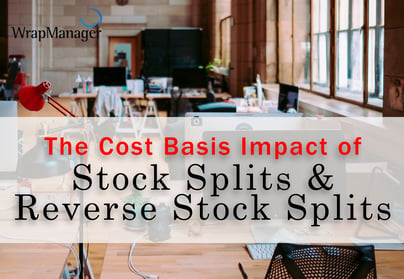 Understanding the Cost Basis Impact of Stock Splits & Reverse Stock Splits
Understanding the Cost Basis Impact of Stock Splits & Reverse Stock Splits
Consider this Scenario
Your friend Bill owns a stock that just went through a 2-for-1 stock split and another stock that had a 3-for-4 reverse stock split. He is unsure how these actions will impact his cost basis per share for these stocks.
Stock Split: A stock split is a corporate action that takes places when a company divides its existing shares into multiples shares to boost the shares liquidity. Although the number of shares outstanding increases by a specific multiple (such as 2-for-1 or 3-for-1) the total value of the shares held by a shareholder does not change. So, if you held 3 shares and the company held a 2-for-1 stock split you would now hold 6 shares, but the total original value would not change.
Reverse Stock Split: A reverse stock split is a corporate action that happens when a company reduces the total number of its outstanding shares. A reverse stock split decreases the number of a company’s outstanding shares by a specific multiple (such as 1-for-5 or 1-for-10) and simultaneously increases the price per share. These are also known as a stock consolidation or share rollback. So, if you held 5 shares valued at $20 each and the company held a 1-for-5 reverse stock split, you would now hold 1 share valued at $100.
A company may have their stock go through a stock split in order to make the stock seem more affordable to smaller investors. A company may have their stock go through a reverse split in order to meet the minimum share price for inclusion on a particular stock exchange.
Bill bought 100 shares of Stock ABC in March at a price of $150.50 each for a total cost basis of $15,050.00. Stock ABC went through a 2-for-1 split in June.
Bill bought 400 shares of Stock XYZ in April at a price of $9.00 each for a total cost basis of $3,600.00. Stock XYZ went through a 3-for-4 reverse split in June.
What is the cost basis per share for Stock ABC after the split? What is the cost basis per share for Stock XYZ after the reverse split?
- The cost basis per share remains the same. The split and reverse split have no impact on the cost basis per share.
- The new cost basis per share of ABC is $75.25. The new cost basis per share of XYZ is $12.00.
- The new cost basis per share of ABC is $301.00. The new cost basis per share of XYZ is $2.1875.
- The new cost basis per share of ABC is $75.25. The new cost basis per share of XYZ is $7.00.
Solution:
2 is the best answer.
To account for a 2-for-1 stock split, the cost basis per share of the original purchase must be adjusted to reflect the stock split. To calculate the new cost basis per share, divide the cost basis per share by the number of new shares you receive per each original share. In this case, divide $150.50 by 2 to get the new cost basis per share of $75.25 ($150.50 / 2 = $75.25).
To calculate the new cost basis for the 3-for-4 reverse stock split, again divide the cost basis per share by the number of new shares you receive per each original share. In this case, divide $9.00 by 0.75 to get the new cost basis per share of $12.00 ($9.00 / 0.75 = $12.00).
Note that the total cost basis remains the same after the split and reverse split, but Bill now has a different number of shares for both tickers. The cost basis per share must be adjusted to reflect the new share amount for each of the stocks.
At the time of the stock split, the number of shares owned is adjusted by the custodian and the share price is adjusted by the exchange. The new cost basis per share should be applied automatically by the custodian but an investor should still double-check the cost basis per share anytime a stock holding goes through a stock split or a reverse split. If the cost basis per share is incorrect, an investor may end up overpaying or underpaying capital gains taxes if the investor is using an incorrect cost basis per share.
This quiz is intended for informational and illustrative purposes only. This material is not intended to be relied on as a forecast, research or investment advice, and is not a recommendation, offer or solicitation to buy or sell any securities or to adopt any investment strategy. The information presented is general information that does not take into account your individual circumstances, financial situation or needs, nor does it present a personalized recommendation to you. The information and opinions contained in this material are derived from sources deemed reliable, are not all-inclusive and are not guaranteed as to accuracy.





